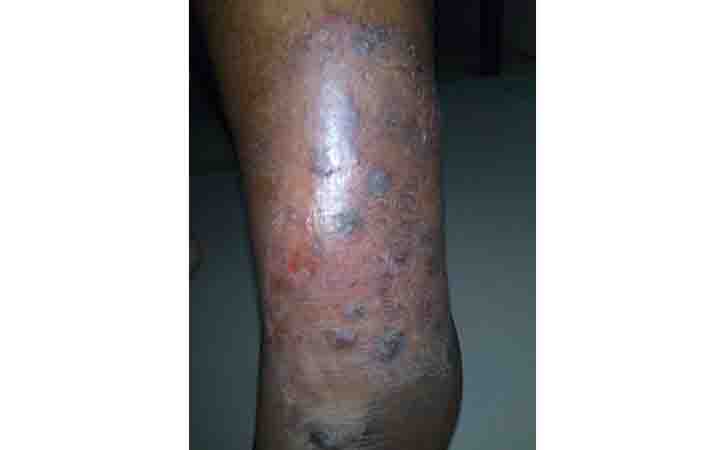Venous Eczema
Venous stasis dermatitis happens when there’s a problem with veins, usually in lower legs in association with venous insufficiency that keeps blood from moving through very well. It occurs as a result of chronic venous hypertension. As more fluid and pressure build, some of the blood leaks out of veins and into the skin.

The condition is also called venous eczema or stasis dermatitis. It is also called gravitational dermatitis. Venous eczema is most often seen in middle-aged and elderly patients—it is reported to affect 20% of those over 70 years. Women are more likely to have it than men. It is associated with:
- History of deep venous thrombosis in affected limb
- History of cellulitis in affected limb
- Chronic swelling of lower leg, aggravated by hot weather and prolonged standing
- Varicose veins
- Venous leg ulcers
Medical treatments can help, and can do many things to get the problem under control.
Itchy, pink, scaling areas develop on a background of the changes of chronic venous hypertension. The affected areas are often around venous ulcers, but the margins of the eczematous process are poorly defined.



Occasionally, the process spreads to the contralateral leg and even to the thighs and arms. In most cases, venous eczema is actually an allergic contact hypersensitivity to one of the substances used to treat the venous ulcer. Such substances include lanolin, neomycin, vioform, ethylene diamine and rubber additives. It has been suggested that some patients develop sensitivity to the breakdown products of their own tissues (autosensitization).
The condition often affects people who have circulation problems. When veins don’t work well, they don’t return blood back to heart like they’re supposed to. Venous eczema appears to be due to fluid collecting in the tissues and activation of the innate immune response.
The veins in legs have one-way valves that help blood move through. Their job is to push blood up legs. As get older or have other health problems, the valves may not work like they should. This is called venous insufficiency.
In some cases this and other conditions can cause pressure to build. Not enough blood and oxygen reach the skin.
Some conditions that make more likely to get venous stasis dermatitis include:
- High blood pressure
- Varicose veins
- Being very overweight
- Heart conditions such as congestive heart failure
- Kidney failure
- A blood clot, especially in leg
- Many pregnancies
- Past surgery or injury in the area
Also may be more likely to have it if usually stand or sit for long periods of time or don’t get much exercise.
Reduce swelling in the leg:
Because circulation is the main issue, doctor may suggest surgery to repair veins. Whether or not that is an option, there are other ways to get the fluid moving in legs. Reduce swelling in the leg are:
- Don’t stand for long periods.
- Take regular walks.
- Elevate feet when sitting: if legs are swollen they need to be above hips to drain effectively.
- Elevate the foot of bed overnight.
- During the acute phase of eczema, bandaging is important to reduce swelling.
- When the eczema has settled, wear graduated compression socks or stockings long term. Fitted moderate to high compression socks can be obtained from a surgical supplies company. Light compression using travel socks may be adequate, and these are easy to put on. They can be bought at pharmacies, travel and sports stores. More compression is obtained by wearing two pairs.
- Horse chestnut extract appears to be of benefit for at least some patients with venous disease.
Treatment the eczema:
- Dry up oozing patches with Condy’s solution (potassium permanganate) or dilute vinegar on gauze as compresses.
- Oral antibiotics such as flucloxacillin may be prescribed for secondary infection.
- Apply a prescribed topical steroid: start with a potent steroid cream applied accurately daily to the patches until they have flattened out. After a few days, change to a milder steroid cream (eg. hydrocortisone) until the itchy patches have resolved (maintenance treatment). Check with doctor if are using steroid creams for more than a few weeks. Overuse can thin the skin, but short courses of stronger preparations can be used from time to time if necessary to control the dermatitis. Coal tar ointment may also help.
- Use a moisturizing cream frequently to keep the skin on the legs smooth and soft. If the skin is very scaly, urea cream may be especially effective.
- Protect skin from injury: this can result in infection or ulceration that may be difficult to heal.
Treatment for varicose veins:
- Seek the opinion of a vascular surgeon regarding varicose veins. These can be treated surgically, by endovenous laser, or sclerotherapy.
- Varicose veins may develop again after apparently successful operation because venous disease is progressive.
To confirm analyze need to visit a doctor. When swelling appears, must need to contact a doctor to start treatment. Also need doctor’s suggestion, when anyone starts antibiotic. Primary doctor may sent to surgery department for varicose veins surgery.
- Roxburgh’s common skin diseases
- Andrew’s Diseases of the skin
Venous Eczema
TUI - Tibot Urgency Index


Venous stasis dermatitis happens when there’s a problem with veins, usually in lower legs in association with venous insufficiency that keeps blood from moving through very well. It occurs as a result of chronic venous hypertension. As more fluid and pressure build, some of the blood leaks out of veins and into the skin.



The condition is also called venous eczema or stasis dermatitis. It is also called gravitational dermatitis. Venous eczema is most often seen in middle-aged and elderly patients—it is reported to affect 20% of those over 70 years. Women are more likely to have it than men. It is associated with:
- History of deep venous thrombosis in affected limb
- History of cellulitis in affected limb
- Chronic swelling of lower leg, aggravated by hot weather and prolonged standing
- Varicose veins
- Venous leg ulcers
Medical treatments can help, and can do many things to get the problem under control.
Itchy, pink, scaling areas develop on a background of the changes of chronic venous hypertension. The affected areas are often around venous ulcers, but the margins of the eczematous process are poorly defined.



Occasionally, the process spreads to the contralateral leg and even to the thighs and arms. In most cases, venous eczema is actually an allergic contact hypersensitivity to one of the substances used to treat the venous ulcer. Such substances include lanolin, neomycin, vioform, ethylene diamine and rubber additives. It has been suggested that some patients develop sensitivity to the breakdown products of their own tissues (autosensitization).
The condition often affects people who have circulation problems. When veins don’t work well, they don’t return blood back to heart like they’re supposed to. Venous eczema appears to be due to fluid collecting in the tissues and activation of the innate immune response.
The veins in legs have one-way valves that help blood move through. Their job is to push blood up legs. As get older or have other health problems, the valves may not work like they should. This is called venous insufficiency.
In some cases this and other conditions can cause pressure to build. Not enough blood and oxygen reach the skin.
Some conditions that make more likely to get venous stasis dermatitis include:
- High blood pressure
- Varicose veins
- Being very overweight
- Heart conditions such as congestive heart failure
- Kidney failure
- A blood clot, especially in leg
- Many pregnancies
- Past surgery or injury in the area
Also may be more likely to have it if usually stand or sit for long periods of time or don’t get much exercise.
Reduce swelling in the leg:
Because circulation is the main issue, doctor may suggest surgery to repair veins. Whether or not that is an option, there are other ways to get the fluid moving in legs. Reduce swelling in the leg are:
- Don’t stand for long periods.
- Take regular walks.
- Elevate feet when sitting: if legs are swollen they need to be above hips to drain effectively.
- Elevate the foot of bed overnight.
- During the acute phase of eczema, bandaging is important to reduce swelling.
- When the eczema has settled, wear graduated compression socks or stockings long term. Fitted moderate to high compression socks can be obtained from a surgical supplies company. Light compression using travel socks may be adequate, and these are easy to put on. They can be bought at pharmacies, travel and sports stores. More compression is obtained by wearing two pairs.
- Horse chestnut extract appears to be of benefit for at least some patients with venous disease.
Treatment the eczema:
- Dry up oozing patches with Condy’s solution (potassium permanganate) or dilute vinegar on gauze as compresses.
- Oral antibiotics such as flucloxacillin may be prescribed for secondary infection.
- Apply a prescribed topical steroid: start with a potent steroid cream applied accurately daily to the patches until they have flattened out. After a few days, change to a milder steroid cream (eg. hydrocortisone) until the itchy patches have resolved (maintenance treatment). Check with doctor if are using steroid creams for more than a few weeks. Overuse can thin the skin, but short courses of stronger preparations can be used from time to time if necessary to control the dermatitis. Coal tar ointment may also help.
- Use a moisturizing cream frequently to keep the skin on the legs smooth and soft. If the skin is very scaly, urea cream may be especially effective.
- Protect skin from injury: this can result in infection or ulceration that may be difficult to heal.
Treatment for varicose veins:
- Seek the opinion of a vascular surgeon regarding varicose veins. These can be treated surgically, by endovenous laser, or sclerotherapy.
- Varicose veins may develop again after apparently successful operation because venous disease is progressive.
To confirm analyze need to visit a doctor. When swelling appears, must need to contact a doctor to start treatment. Also need doctor’s suggestion, when anyone starts antibiotic. Primary doctor may sent to surgery department for varicose veins surgery.
- Roxburgh’s common skin diseases
- Andrew’s Diseases of the skin




